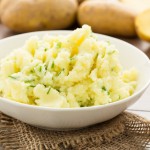Fish pie is a classic dish. By mixing a variety of fish in with a deliciously cheesy sauce it’s a great way to introduce more fish to kids, and by adding some green goodness in the form of spinach it’s a win, win!
Serve with steamed seasonal vegetables.
Skills Check
Follow a recipe; follow food safety & hygiene rules; tidy away; use a measuring jug to measure liquids; use weighing scales; chop using bridge/claw technique safely; use a box grater safely; mash; use the hob (with adult supervision).
Allergens
Gluten | Fish | Milk
(Please note the allergens listed are indicative only. Allergens vary depending on brand; check the labels on the products you use.)
Equipment
Weighing scales, measuring jug, box grater, masher, fork, knife, chopping board, saucepan, wooden spoon, casserole dish.
Ingredients (serves 4):
- 900g assorted fish - a mixture of white (cod) and brown (salmon, tuna) is good
- 200g spinach
- 1/2 pint of semi skimmed milk
- 20g butter
- 20g plain flour
- 55g cheddar cheese, reduced fat, grated
- Black pepper
- Mashed potato
- Extra cheese and breadcrumbs to sprinkle on top
Method
- Cut the fish into bite size pieces and place in a casserole dish with the spinach.
- Melt the butter in a saucepan and stir in the flour. Cook stirring for one minute.
- Remove the pan from the heat and gradually stir in the milk.
- Return the pan to the heat and stir until boiling. Simmer, stirring well, for 2 minutes. Remove from the heat.
- Add the cheese and mix well. Season to taste with black pepper.
Pour the cheese sauce over the raw fish and spinach and mix carefully. - Top with the mashed potato and rough up the top with a fork.
- Finish the top off by sprinkling with a mixture of breadcrumbs and grated cheese.
- Bake for 30-40 minutes at 190°C until golden brown and bubbling.
So thinking about Phunky Fish Pie ...

Potatoes are a nutritious and filling starchy food; low in fat and a source of vitamin C and fibre.
Spinach is a rich source of vitamins and minerals, as well as other valuable compounds (antioxidants and bioflavonoids) known to be good for our health.
Nutritional Information
| - | Energy | 2290kJ / 547kcal | 27% |
| High | Fat | 26.0g | 37% |
| High | Saturates | 10.2g | 51% |
| Low | Sugar | 5.1g | 6% |
| Low | Salt | 1.0g | 17% |
per 397g serving
% of an adult's reference intake
Typical values per 100g: Energy 577kJ / 138kcal
Notes
A traffic light system is used on nutrition labels to make it easier to see which foods and drinks are lower in calories, fat, sugar and salt. Try and choose more ‘greens’ and ‘ambers’ and fewer ‘reds’, and stick to smaller portions of ‘reds’.
Just because a recipe or a food has a red traffic light doesn't mean you shouldn't eat it. Understanding why a food or recipe might have a red light can be helpful. For example oily fish is high in total fat and so any recipe containing oily fish is likely to be ‘red’ for fat. But it is recommended that we eat oily fish at least once a week because the type of fat it contains is beneficial for our health.
% Reference Intakes are also shown. Reference Intakes are guidelines about the approximate amount of particular nutrients and energy required for a healthy diet (based on an average-sized woman doing an average amount of physical activity). Most children will require less than these Reference Intakes. The contribution of one serving of a food or drink to the Reference Intake for each nutrient is expressed as a percentage.




